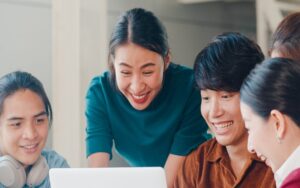
Writing your thesis involves thinking about the software used, its presentation, the management and presentation of your bibliographic references, the rights of the content you reuse, etc.
What software should I use to write my thesis?
Proprietary software whose use is regulated by Microsoft. Generally delivered with other Office Suite software (Excel, PowerPoint, and sometimes others such as Visio, One Note, Publisher or Silver Light), Word is paid software. Different versions exist: 2003, 2007, 2010, 2011 and 2019 are the most recent.
Its use is quite intuitive, at least for beginners, and for writing short texts. It is a software that has a WYSIWYG interface (what you see is what you get), which allows you to view in real time and approximately what the text will give once printed. However, using Word to edit long texts requires some practice:only 10% of the many features of this editor are actually used by its users . It also happens that, for reasons that are sometimes difficult to identify, Word bugs (title that does not appear in the table of contents, indentation not taken into account, etc.).
Word allows you to edit files in .doc or .docx format(“native” format of Word files, one of the most used), but also in formats that facilitate exchanges and interoperability between different software, such as .rtf (Rich Text Format, a non-proprietary format supported by all software, which preserves the content and almost all document formatting), .txt (plain text, which loses most formatting information), .odt (OpenDocument, for versions later than 2007) or .html (to create web pages). It also allows files to be exported in .pdf format (Portable Document Format, non-proprietary format developed by Adobe, which allows formatting to be fixed, in particular for file exchange without loss of data).
Training sessions on advanced formatting functions for the 2010 version of Word (on PC) are offered by the SCD. Consult the training program and register online . You can also download our tutorial .
Download Word from the official Microsoft page (paid).
The free solution: Open Office writer and its derivatives
Free software (whose use, study, modification and duplication with a view to its dissemination are technically and legally permitted, in order to guarantee certain induced freedoms, including control of the program by the user and the possibility of sharing between individuals) and free, belonging to the OpenOffice office suite originally developed by OpenOffice.org. Following the takeover of the company by Oracle, a split took place within it, and the software available today is Apache OpenOffice Writer and LibreOffice Writer (supported by the Free Software Foundation).
OpenOffice was designed from the start as a free and open-source alternative to Microsoft’s office suite.It works with Windows, MacOS (NeoOffice) and Linux operating systems. Its latest versions date from 2018 for Apache OpenOffice, 2016 for NeoOffice and 2019 for LibreOffice.
Its functionalities are very similar to those of Word, as well as its use. It is also a software with WYSIWYG interface. Again, managing heavy and long files requires some skill, and bugs are not non-existent.
Open Office and its derivatives make it possible to edit documents in .odt format (OpenDocument, native format developed by OpenOffice.org, but not compatible with versions of Word prior to 2007), but also other formats favoring exchanges and interoperability: .doc, .rtf, .txt, .html etc. It also allows the export of documents in .pdf format.
You can also download our tutorial dedicated to managing long documents in Open Office.
Beyond word processing: LaTeX and its derivatives
LaTeX (pronounced Latek) is free, open-source software, originally designed to run on Linux but works equally well on Mac OS and Windows.
Contrary to the software presented previously, whose WYSIWYG interface allows you to immediately have an idea of what the result will be when printed, LaTeX is a WYSIWYM type software (what you see is what you mean, what you see is what you mean), which completely separates the substance of your text (this is a title, this is a paragraph, this is a large part) from its form (I want the part titles to be bold, and chapter titles in italics). Under LaTeX, everything is done in command lines, with a syntax similar to HTML (tags). For example, if you want to italicize an expression, this is what you would type.
You just have to declare your objects (this is a paragraph title, this is an image, this is a list, this is an appendix in landscape format, etc.), and the program takes care of adapting its formatting and layout in order to obtain the most “ergonomic” document possible. These features are particularly appreciated by scientists, who have to write equations with very specific and precise layouts, and linguists who work with non-Latin characters.
Learning these command lines requires a little getting used to, but not necessarily much longer than learning the advanced features of Word or OpenOffice. The advantage of LaTeX over these more intuitive software is its bug-free management of the layout of long documents, precisely because of the form/content separation.
LaTeX saves the render file and the source files in different documents, unlike software like Word or OpenOffice. This is what makes bugs difficult to identify in these. If the source files from which LaTeX works are rather arid to consult (command lines), it is possible to produce .pdf, .dvi or .ps files, which will allow you to “see” the rendering of your work.
As long as we choose to look in detail at the commands we may need (justification of tables and graphs, management of equations, management of indexes, etc.), LaTeX offers a greater and more stable variety of commands than Word or Open Office. However, if you don’t need to deal with long, structured or layout-tricky documents, maybe you won’t need to dive into it.








